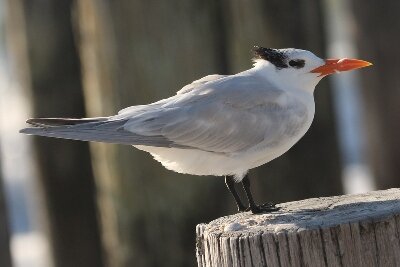Royal Tern
Thalasseus maxima (Boddaert, 1783)
Photo © Kris Webb
STATUS
North America, Latin America and Africa. Polytypic.
OVERVIEW
Species not admitted nationally during the period covered (BOU 1971).
NOT PROVEN
0). 1920 Sussex Pevensey Marsh, male, shot, 17th January.
(Walpole-Bond, 1938).
[E. M. Nicholson & I. J. Ferguson-Lees, British Birds 55: 299-384 HR].
History Walpole-Bond (1938 (3): 260) says: 'A Royal Tern - wrongly christened by Arthur Griffith (Cat. B. Dyke Rd. Mus., B'ton, 5th ed. (1927), Hist. of the Collection, p. xxiii) - of the form Sterna maxima albidorsalis Hartert, found on the West African coast from Gibraltar to Angola, was shot in Pevensey Marsh on January 17th, 1920. It is, however, accounted unauthentic...This bird is at present in the Church Street Museum, Brighton. It came from the Crewe collection.'
Comment Hastings rarity. Not acceptable.
0). 1954 Norfolk Lynn Point, 1st September.
(I. T. C. Nisbet, Cambridge Bird Club Report 1954: 15-16).
[I. T. C. Nisbet, Cambridge Bird Club Report 1954: 15-16].
History I. T. C. Nisbet (1954) in the Cambridge Bird Club Report, Vol. XXVIII. p. 15, says: 'Lynn Point, a very large tern, about as large as a Common Gull, flew inland on Sept. 1st. Its most striking character in a rather brief view was its extremely large, heavy, pale, orange-red bill. In build it resembled a rather heavy Common Tern (a noticeably short tail not being seen), and its forehead was more or less white, contrasting somewhat with the darker crown. It was at first thought to be a Caspian Tern Hydroprogne caspia, but it was later found that the description fitted more closely a Royal Tern Sterna maxima. Examination of skins supported this view, but specific identification can hardly be claimed on this evidence, though the bird was undoubtedly one of these two rare species (I.C.T.N.).'
